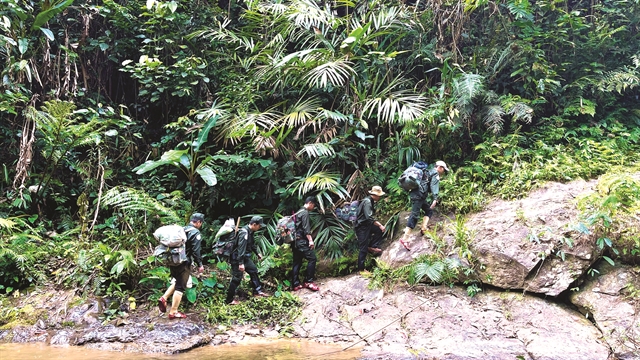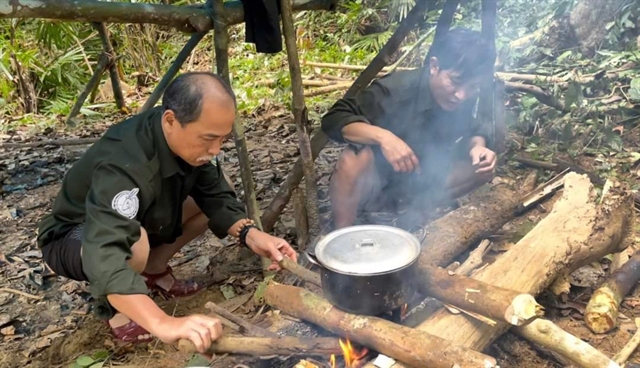Weather:
- Ha Noi 25oC
- Da Nang 25oC
- Ho Chi Minh 31oC
Công Thành
Hopes have been raised of finding one of the world’s rarest large mammals, as local villagers reported that some forest taro plants were grazed at root by unidentified hoofed animals in the former central province of Quảng Nam, which is now part of Đà Nẵng City.
Conservationists have been tracking the saola (Pseudoryx nghetinhensis) or Asian bicorn in central Việt Nam ever since the last photo of the endangered species was captured in the province in 2013.
“The new discovery could be evidence of the saola, as the species used to nibble the taro from stem to root. Meanwhile, chamois and Annamite striped rabbit species also prefer eating forest taro, but only the upper part,” says Lê Hoàng Sơn, director of Saola Reserve's management board.
A network of camera traps had been set up to snap the critically endangered species in the reserve, but it is still missing.
“We keep boosting the protection and conservation of rich biodiversity and landscape in the saola habitat in the reserve, with a hope of snapping its appearance,” Sơn says.
He says protection of forest over past decades not only conserves the habitat for the saola, but also other endangered species including chamois, Annamite striped rabbits and Sunda pangolins that had been recorded by camera traps.
Tracking tactics

Nguyễn Văn Linh, a post-graduate conservationist from Đà Nẵng University of Education and Science, began research on the endangered Annamite striped rabbit in 2023 in the jungles of Nghệ An and Quảng Nam – two major centres of the rabbit species.
Linh says research of the striped rabbit is rare in Việt Nam, and the study on the species will lead to getting closer to the saola, as the two species have a similar environment and favourite sources of food.
“The striped rabbit is my main focus of study, but it would be interesting if I could find some trace of the saola,” Linh says.
The young conservationist says he found a rabbit born in a cave one month after setting up cameras.
“It’s very interesting. The mother rabbit was pregnant when I installed camera traps at its cave. The baby rabbit was born after I left the scene,” he says.
Linh says he checked the rabbits, and the camera trap had recorded the mother visiting her baby at night after a day-long search for food.

About 80 per cent of human activities in the area include illegal hunting, logging and seeking medicinal herbs and other forestry products, Linh says.
However, wildlife awareness programmes with forest patrol trips have been regularly implemented by the ranger force and the community living near the reserve.
Ranger Hồ Quốc Cường says the local community acknowledge the law on forest protection and wildlife trafficking.
“The Cơ Tu ethnic group, a major population living near the reserve, often receives communications on illegal traps and shootings. They all know the strict penalties for illegal wildlife hunting and trafficking. Key leaders of the community were invited to join us in forest patrol monthly,” Cường says.
A Lăng Đăng, a Cơ Tu man, who was previously a hunter, voluntarily participates in the reserve’s ranger force in protection of wildlife and forest. Đăng persuades animal and timber poachers to cease their illegal actions, and seek environment-friendly jobs.
Protection teams
The reserve's director, Lê Hoàng Sơn, says improving livelihoods for the Cơ Tu community is good for sustainable forest protection, while eliminating illegal hunting and logging.
He says hunting by snares and traps has mostly been eliminated, but some households living in poverty still earn from poaching forestry products.
“We have established 17 community-based forest protection teams to deal with forest violations. These teams often assign members to join the rangers in patrol missions in the reserve,” Sơn says.

“Around 8,500ha out of 15,000ha have been assigned for community-based protection, and the local community benefits from an annual fund of VNĐ11 billion (US$418,000) from forest environment services payment as an extra income,” Sơn adds.
“The reserve management has been cooperating with local authorities in creating stable income for the community from eco-farming and community-based tourism services. It aims at reducing forest impact activities among the local residents,” he explains.
Sơn says joint-patrol trips are designed among the saola management boards of the former provinces of Quảng Nam and Thừa Thiên Huế in searching the forest-dwelling bovine in Trường Sơn mountain range.
According to the World Wide Fund for Nature (WWF), the saola species was defined following a discovery of remains in 1992 in Vũ Quang nature reserve in Hà Tĩnh Province. A living saola in the wild was first photographed in 1999 by cameras set up by the WWF, and again in Quảng Nam in 2013.
Since discovery, only about 10 saola have ever been captured alive. They were all caught by local villagers in Laos and Việt Nam, but without professional veterinary and husbandry care, the longest any of the animals lived was a few months at most.
The last saola known to be captured alive was in 2010 in a village in Laos. It died in less than a week.
Biologists have also only photographed the species five times in the wild in the last 25 years, all by camera traps – twice in Laos and three times in Việt Nam.
Nguyễn Đại Anh Tuấn, who is currently vice director of Huế municipal department of Agriculture and Environment, rescued a pregnant saola in former A Lưới district in 1997.

Tuấn may be a rare witness of a living saola as well as newborns, but the search for the elusive saola continues. VNS
